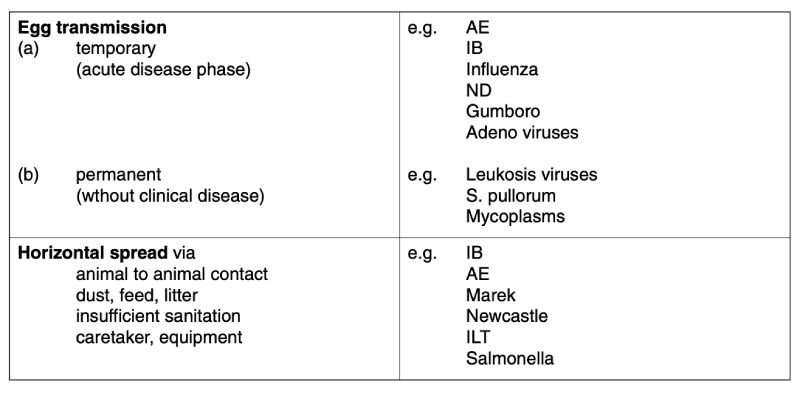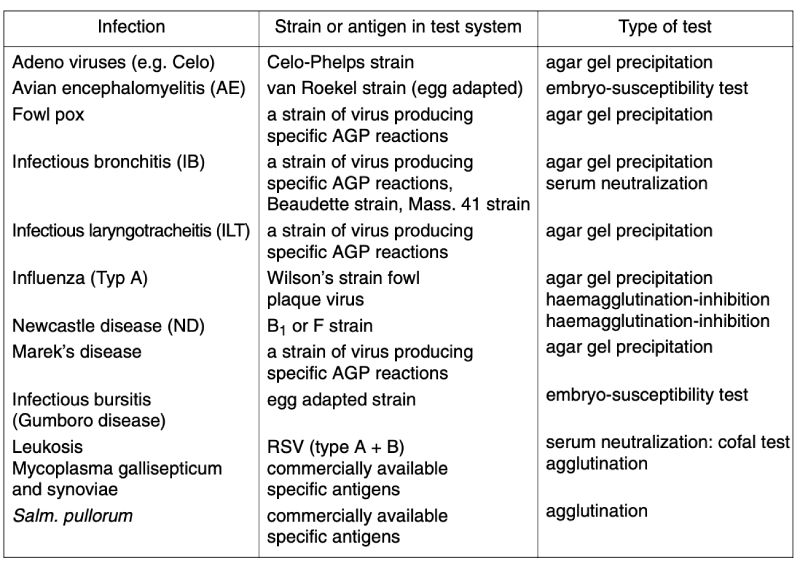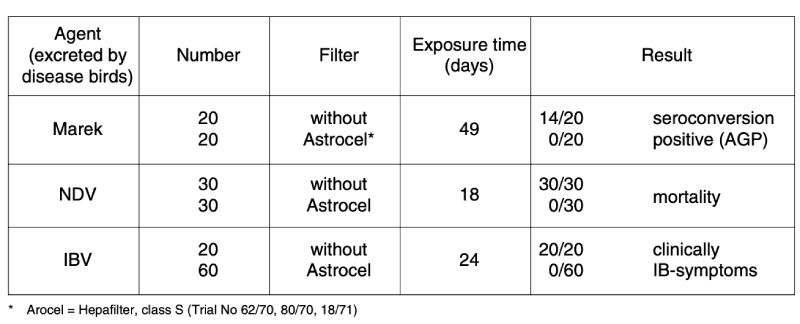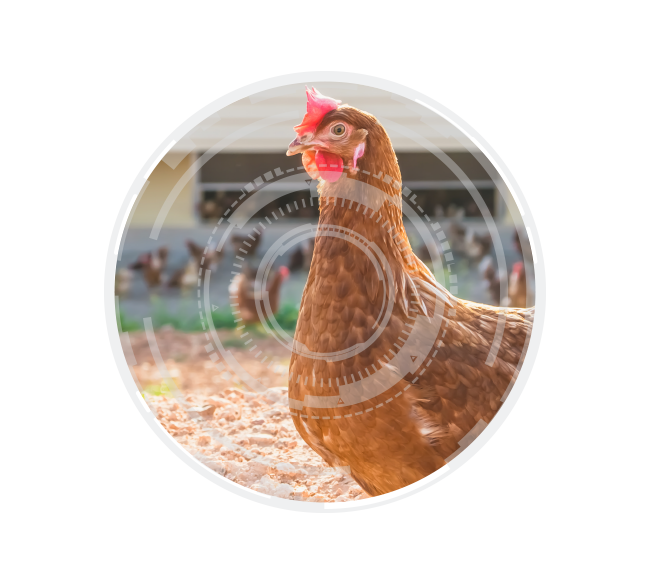Heinz Lohmann, the founder of our company, always admired Americans with their scientific approach
to business. Between 1956 and 1958 he signed license agreements with American poultry breeders
Nichols and Heisdorf & Nelson for die multiplication and distribution of broilers and layers, respectively.
With these cooperations he established a basis for transferring knowledge from the USA to Germany
between geneticists, nutritionists and veterinarians.
In the late 1950s, a close cooperation and personal friendship developed between veterinarians of the Lohmann Veterinary Laboratory (Drs. Landgraf, Vielitz and Kirsch), their colleagues at the H&N Veterinary Laboratory (Dr. Zander and others) and Prof. Roy Luginbuhl, virologist at the University of Connecticut.
While German veterinarians still knew only two or three typical poultry diseases – coccidiosis, pullorum and Marek’s – Luginbuhl had recognized as early as 1958 that eggs used for multiplication of virus had to come from flocks free of latent infections (Luginbuhl et al., 1967). Chicken embryos were first used for virus studies by Rous und Murphy (1911). It took twenty more years before Woodruff and Goodpasture (1931) used chicken embryos fort the multiplication of pox virus.
Beveridge and Burnet (1946) still stated: „there is no authentic report demonstrating that chicken embryos are viral vectors, and it is much easier in poultry to prevent the passage of viral diseases than in other free roaming species“. In his review of poultry diseases, Cottral (1952) listed 9 infectious agents which are transmitted vertically by chicken embryos: Leukosis, AE, ND, Infektious Sinusitis (Mykoplasmosis), Psittakosis, Tuberkulosis, Chicken Typhus and Parathyphus. In the following years Adeno virus was shown to be transmitted by hatching eggs, and several reports confirmed Cottral’s earlier report. Significant developments were the discovery of „Resistence inducing factors“ (RIF) by Rubin (1960) to check for the presence of Leukosis virus and the Cofal test by Sarma (Sarma et al., 1964) a complement fixation test to check for group specific Leukosis antigens. Kottaridis et al. (1966) developed a serological test to detect Leukosis antibodies.
Luginbuhl started in 1963 to establish SPF chicken flocks at the University of Connecticut. He used Mount Hope White Leghorns, unfortunately not a very productive strain, and called the program „ SPAFAS“ (Specific pathogen free avian supply). According to the definition of the International Society for Laboratory Animals, SPF chickens are kept in flocks routinely monitored for specified pathogens, with negative results to date. Without specifying the pathogens, the label „SPF“ is not indicative of the quality of the eggs and their suitability for experimental purposes.
Following Luginbuhl’s advice, we started in 1963 to reproduce and rear flocks of chickens in Cuxhaven under isolated conditions und to monitor their health status. Table 1 shows routes of infection in chickens, table 2 the plan for laboratory tests. From 1963 to 1965, we used HNL laying hens, then changed to stock imported from SPAFAS. We compared house type A with negative air pressure vs. house B with positive air pressure and filtered air (FAPP), as described by Drury et al. (1969). Results are shown in table 3.
The number of hens per house varied between 200 and 2.000, and the total volume tested between 1963 and 1970 was about 4.000 hens in house A, 14.000 hens in house B. In 1966 the cooperation between SPAFAS and Lohmann was formalized, the contract signed 20.09.1966.
In further trials we tested the effectiveness of air filters. The results shown in table 4 convinced us that FAPP conditions with special high efficiency filters are essential to maintain SPF flocks successfully with predictable results (Vielitz et al., 1974). An important part of our learning process was to determine the optimal air pressure to combine zero disease risk with normal bird behaviour as an indicator of bird welfare (if air pressure is too high, birds may respond with extreme nervousness).




In 1968 new FAPP houses were built in Großenhain near Bederkesa, and this reference date was chosen as the basis for the 40th anniversary we are celebrating this year. With the „all in“ „all out“ system, 2.000 day-old pullets and a corresponding number of cockerels are housed and kept in the same facilities to the end of the laying period.
The SPAFAS hens were soon replaced by more productive HNL White Leghorns. A small house (Farm Elbeck in Altenbruch) was equipped with individual cages, in which HNL hens were kept and subjected to rigorous tests for leukosis virus and other disease agents (Vielitz et al., 1974). The third generation after confirmed 100% negative test results was used as source of hatching eggs to reproduce the first flock from HNL stock for the SPF farm in Großenhain.
In this region Lohmann had leased a large area of woodland in which broiler breeders were reared from 8 weeks of age under free range conditions. We first thought free range management should be beneficial for rearing breeding stock in fresh air with ample exercise, but soon learned that free range also involved high mortality (mainly due to parasitic diseases), resulting in poor development of the chickens – a fact rediscovered in our time, 40 years later, by many poultry people while changing from conventional cages to free range management of layers. Besides poultry diseases, foxes and birds of prey contributed to high losses.
Since 1968 we are using the trade name „VALO“ (Vakzine Lohmann).
Several people contributed significantly to the success and increasing sales volume of VALO eggs during the first decades: production manager Widukind Ruttke, sales manager Hartwig Morrise and from the staff of the Veterinary Laboratory especially Dr. Helga Landgraf, Dr. Kirsch, Mrs. HollandLetz and the author of this review.
The first scientist who used VALO SPF embryos as basis for human vaccines was Prof. Voß at the Robert Koch Institute in Berlin. Our collaboration started in the 1980s in connection with his development of yellow fever vaccines, and we owe many useful suggestions for our laboratory work to his advice.
The sale of VALO eggs was initially organized through TAD, while the Veterinary Laboratory of Lohmann produced and sold vaccines from VALO eggs. I reported on the establishment of SPF chicken populations and their use during an international symposium held at the Veterinary College in Hannover in November 1967. We also reported about our experience with the management of SPF chicken flocks at the 12th International Congress for Biological Standardization in September 1971 in Annecy, France (Vielitz and Landgraf, 1972).
To keep up with the growing demand for SPF eggs, we converted the floor houses to colony cages in the mid 1970s and thereby doubled the capacity.
The SPF status of our VALO flocks has been certified by State Veterinary authorities from the beginning while the Lohmann Veterinary Laboratory continued internal monitoring of all flocks.
In a joint project with the University of Giessen (Prof. Bauer, Dr. Fries), we tried to establish flocks free of endogenous provirus (chf – chicken helper factor), but this turned out to be very difficult. The productivity of chf-negative hens was very poor and no commercial demand for the product developed.
Another research project, in the late 1980s, was conducted in cooperation with the Free University of Berlin (Prof. Monreal, Prof. von Bülow) to establish a flock free of chicken anemia virus (CAV). This project was very successful and enabled Lohmann Tierzucht to produce CAV-free SPF eggs as the first company in the world. From CAV-free VALO eggs, we could then produce the first live CAV vaccine (Thymovac) for world-wide distribution.
VALO has been at the forefront of innovative research during its 40 year history, and SPF chicken embryos will remain essential for research and the production of poultry vaccines in the foreseeable future.
Beveridge, W.I.B. and F.M. Burnet (1946): The cultivation of viruses and rickettsia in the chick embryo. Medical Research Council, Special Report No. 256, Her Majesty’s Stationary Office, London.
Cottral, G.E. (1962): Endogenous viruses in the egg. Ann. N.Y. Acad. Sci. 55: 221-235.
Drury, L.N., W.C. Patterson and C.W. Beard (1969): Ventilating poultry houses with filtered air under positive pressure to prevent airborne diseases. Poultry Sci. 48: 1640-1646.
Kottaridis, S.D., T.W. Chomiac and R.E. Luginbuhl (1966): A metabolism inhibition test (MIT) for Rous sarcoma virus antibodies. Avian Diseases 10: 337-341.
Luginbuhl, R.E., R. Holdenrieth and R.E. Stevenson (1967): Establishment and maintenance of a specific pathogen free (SPF) flock of White Leghorn chickens. Scientific contribution No. 292, Agric. Exp. Station, Univ. of Connecticut, Storrs.
Proc. 10th International Microbiology Congress, Prague.
Rous, P. and I.B. Murphy (1911): Tumor implantations in the developing embryos; experiments with a transmissible sarcoma of the fowl. J. Am. Med. Association 56: 741-742.
Rubin, H. (1960): A virus in chick embryos which induces resistance in vitro to infection with Rous sarcoma virus. Proc. Natl. Acad. Sci. Washington 46: 1105-1119.
Sarma, P.S., H.C. Turner and R.J. Huebner (1964): An avian leukosis group specific complement fixation reaction. Application for the detection and assay of non-cytopathogenic leukosis viruses. Virology 23: 313-321.
Vielitz, E. and Helga Landgraf (1972): In: Proc. Immunobiological Standard 5: 158-162. Karger, Basel.
Vielitz, E., Helga Landgraf and R.E. Luginbuhl (1974): Testmethoden für die Untersuchung von SPF-Geflügelherden. DTW 81: 507-508.
Woodruff, A.M. and E.W. Goodpasture (1931): Susceptibiliy of chorioallantoic membrane of chick embryo to infection with fowl pox virus. Am. J. Pathology 7: 209-222.
In diesem Referat wird an die Entwicklung von VALO SPF seit den ersten Anfängen Mitte der 1960er Jahre erinnert. Aus der anfänglichen Notwendigkeit, die eigenen Zuchttierbestände frei von übertragbaren Krankheiten zu halten, entwickelte sich im Laufe der vergangenen vier Jahrzehnte ein wichtiger, hoch spezialisierter Produktionszweig der Lohmann Tierzucht: die Erzeugung von SPFEiern für die Impfstoffproduktion. Der Import von Knowhow aus den USA setzte sich fort in eigener Forschungstätigkeit des LTZ Veterinärlabors und in der Zusammenarbeit mit europäischen Forschungseinrichtungen. Zu den herausragenden Beiträgen zur Gesundheit von Geflügelbeständen weltweit gehört die Entwicklung von CAV (Hühneranämie Virus) freien Beständen zur Produktion von Geflügelimpfstoffen aus CAV-freien SPF Bruteiern.
In the late 1950s, a close cooperation and personal friendship developed between veterinarians of the Lohmann Veterinary Laboratory (Drs. Landgraf, Vielitz and Kirsch), their colleagues at the H&N Veterinary Laboratory (Dr. Zander and others) and Prof. Roy Luginbuhl, virologist at the University of Connecticut.
While German veterinarians still knew only two or three typical poultry diseases – coccidiosis, pullorum and Marek’s – Luginbuhl had recognized as early as 1958 that eggs used for multiplication of virus had to come from flocks free of latent infections (Luginbuhl et al., 1967). Chicken embryos were first used for virus studies by Rous und Murphy (1911). It took twenty more years before Woodruff and Goodpasture (1931) used chicken embryos fort the multiplication of pox virus.
Beveridge and Burnet (1946) still stated: „there is no authentic report demonstrating that chicken embryos are viral vectors, and it is much easier in poultry to prevent the passage of viral diseases than in other free roaming species“. In his review of poultry diseases, Cottral (1952) listed 9 infectious agents which are transmitted vertically by chicken embryos: Leukosis, AE, ND, Infektious Sinusitis (Mykoplasmosis), Psittakosis, Tuberkulosis, Chicken Typhus and Parathyphus. In the following years Adeno virus was shown to be transmitted by hatching eggs, and several reports confirmed Cottral’s earlier report. Significant developments were the discovery of „Resistence inducing factors“ (RIF) by Rubin (1960) to check for the presence of Leukosis virus and the Cofal test by Sarma (Sarma et al., 1964) a complement fixation test to check for group specific Leukosis antigens. Kottaridis et al. (1966) developed a serological test to detect Leukosis antibodies.
Luginbuhl started in 1963 to establish SPF chicken flocks at the University of Connecticut. He used Mount Hope White Leghorns, unfortunately not a very productive strain, and called the program „ SPAFAS“ (Specific pathogen free avian supply). According to the definition of the International Society for Laboratory Animals, SPF chickens are kept in flocks routinely monitored for specified pathogens, with negative results to date. Without specifying the pathogens, the label „SPF“ is not indicative of the quality of the eggs and their suitability for experimental purposes.
Following Luginbuhl’s advice, we started in 1963 to reproduce and rear flocks of chickens in Cuxhaven under isolated conditions und to monitor their health status. Table 1 shows routes of infection in chickens, table 2 the plan for laboratory tests. From 1963 to 1965, we used HNL laying hens, then changed to stock imported from SPAFAS. We compared house type A with negative air pressure vs. house B with positive air pressure and filtered air (FAPP), as described by Drury et al. (1969). Results are shown in table 3.
The number of hens per house varied between 200 and 2.000, and the total volume tested between 1963 and 1970 was about 4.000 hens in house A, 14.000 hens in house B. In 1966 the cooperation between SPAFAS and Lohmann was formalized, the contract signed 20.09.1966.
In further trials we tested the effectiveness of air filters. The results shown in table 4 convinced us that FAPP conditions with special high efficiency filters are essential to maintain SPF flocks successfully with predictable results (Vielitz et al., 1974). An important part of our learning process was to determine the optimal air pressure to combine zero disease risk with normal bird behaviour as an indicator of bird welfare (if air pressure is too high, birds may respond with extreme nervousness).
Table 1: Routes of natural infection in poultry

Table 2: Monitoring scheme for SPF chicken flocks

Table 3: Infections occurring in SPF chicken flocks using different ventilation (1963 – 1970)

Table 4: Prevention of Virusinfection by airfiltration
Transmission trials, exp. house Vet. Labor

In 1968 new FAPP houses were built in Großenhain near Bederkesa, and this reference date was chosen as the basis for the 40th anniversary we are celebrating this year. With the „all in“ „all out“ system, 2.000 day-old pullets and a corresponding number of cockerels are housed and kept in the same facilities to the end of the laying period.
The SPAFAS hens were soon replaced by more productive HNL White Leghorns. A small house (Farm Elbeck in Altenbruch) was equipped with individual cages, in which HNL hens were kept and subjected to rigorous tests for leukosis virus and other disease agents (Vielitz et al., 1974). The third generation after confirmed 100% negative test results was used as source of hatching eggs to reproduce the first flock from HNL stock for the SPF farm in Großenhain.
In this region Lohmann had leased a large area of woodland in which broiler breeders were reared from 8 weeks of age under free range conditions. We first thought free range management should be beneficial for rearing breeding stock in fresh air with ample exercise, but soon learned that free range also involved high mortality (mainly due to parasitic diseases), resulting in poor development of the chickens – a fact rediscovered in our time, 40 years later, by many poultry people while changing from conventional cages to free range management of layers. Besides poultry diseases, foxes and birds of prey contributed to high losses.
Since 1968 we are using the trade name „VALO“ (Vakzine Lohmann).
Several people contributed significantly to the success and increasing sales volume of VALO eggs during the first decades: production manager Widukind Ruttke, sales manager Hartwig Morrise and from the staff of the Veterinary Laboratory especially Dr. Helga Landgraf, Dr. Kirsch, Mrs. HollandLetz and the author of this review.
The first scientist who used VALO SPF embryos as basis for human vaccines was Prof. Voß at the Robert Koch Institute in Berlin. Our collaboration started in the 1980s in connection with his development of yellow fever vaccines, and we owe many useful suggestions for our laboratory work to his advice.
The sale of VALO eggs was initially organized through TAD, while the Veterinary Laboratory of Lohmann produced and sold vaccines from VALO eggs. I reported on the establishment of SPF chicken populations and their use during an international symposium held at the Veterinary College in Hannover in November 1967. We also reported about our experience with the management of SPF chicken flocks at the 12th International Congress for Biological Standardization in September 1971 in Annecy, France (Vielitz and Landgraf, 1972).
To keep up with the growing demand for SPF eggs, we converted the floor houses to colony cages in the mid 1970s and thereby doubled the capacity.
The SPF status of our VALO flocks has been certified by State Veterinary authorities from the beginning while the Lohmann Veterinary Laboratory continued internal monitoring of all flocks.
In a joint project with the University of Giessen (Prof. Bauer, Dr. Fries), we tried to establish flocks free of endogenous provirus (chf – chicken helper factor), but this turned out to be very difficult. The productivity of chf-negative hens was very poor and no commercial demand for the product developed.
Another research project, in the late 1980s, was conducted in cooperation with the Free University of Berlin (Prof. Monreal, Prof. von Bülow) to establish a flock free of chicken anemia virus (CAV). This project was very successful and enabled Lohmann Tierzucht to produce CAV-free SPF eggs as the first company in the world. From CAV-free VALO eggs, we could then produce the first live CAV vaccine (Thymovac) for world-wide distribution.
VALO has been at the forefront of innovative research during its 40 year history, and SPF chicken embryos will remain essential for research and the production of poultry vaccines in the foreseeable future.
Beveridge, W.I.B. and F.M. Burnet (1946): The cultivation of viruses and rickettsia in the chick embryo. Medical Research Council, Special Report No. 256, Her Majesty’s Stationary Office, London.
Cottral, G.E. (1962): Endogenous viruses in the egg. Ann. N.Y. Acad. Sci. 55: 221-235.
Drury, L.N., W.C. Patterson and C.W. Beard (1969): Ventilating poultry houses with filtered air under positive pressure to prevent airborne diseases. Poultry Sci. 48: 1640-1646.
Kottaridis, S.D., T.W. Chomiac and R.E. Luginbuhl (1966): A metabolism inhibition test (MIT) for Rous sarcoma virus antibodies. Avian Diseases 10: 337-341.
Luginbuhl, R.E., R. Holdenrieth and R.E. Stevenson (1967): Establishment and maintenance of a specific pathogen free (SPF) flock of White Leghorn chickens. Scientific contribution No. 292, Agric. Exp. Station, Univ. of Connecticut, Storrs.
Proc. 10th International Microbiology Congress, Prague.
Rous, P. and I.B. Murphy (1911): Tumor implantations in the developing embryos; experiments with a transmissible sarcoma of the fowl. J. Am. Med. Association 56: 741-742.
Rubin, H. (1960): A virus in chick embryos which induces resistance in vitro to infection with Rous sarcoma virus. Proc. Natl. Acad. Sci. Washington 46: 1105-1119.
Sarma, P.S., H.C. Turner and R.J. Huebner (1964): An avian leukosis group specific complement fixation reaction. Application for the detection and assay of non-cytopathogenic leukosis viruses. Virology 23: 313-321.
Vielitz, E. and Helga Landgraf (1972): In: Proc. Immunobiological Standard 5: 158-162. Karger, Basel.
Vielitz, E., Helga Landgraf and R.E. Luginbuhl (1974): Testmethoden für die Untersuchung von SPF-Geflügelherden. DTW 81: 507-508.
Woodruff, A.M. and E.W. Goodpasture (1931): Susceptibiliy of chorioallantoic membrane of chick embryo to infection with fowl pox virus. Am. J. Pathology 7: 209-222.
Zusammenfassung
VALO SPF: Erinnerungen an die Entwicklung der SPF-Eierproduktion in CuxhavenIn diesem Referat wird an die Entwicklung von VALO SPF seit den ersten Anfängen Mitte der 1960er Jahre erinnert. Aus der anfänglichen Notwendigkeit, die eigenen Zuchttierbestände frei von übertragbaren Krankheiten zu halten, entwickelte sich im Laufe der vergangenen vier Jahrzehnte ein wichtiger, hoch spezialisierter Produktionszweig der Lohmann Tierzucht: die Erzeugung von SPFEiern für die Impfstoffproduktion. Der Import von Knowhow aus den USA setzte sich fort in eigener Forschungstätigkeit des LTZ Veterinärlabors und in der Zusammenarbeit mit europäischen Forschungseinrichtungen. Zu den herausragenden Beiträgen zur Gesundheit von Geflügelbeständen weltweit gehört die Entwicklung von CAV (Hühneranämie Virus) freien Beständen zur Produktion von Geflügelimpfstoffen aus CAV-freien SPF Bruteiern.








